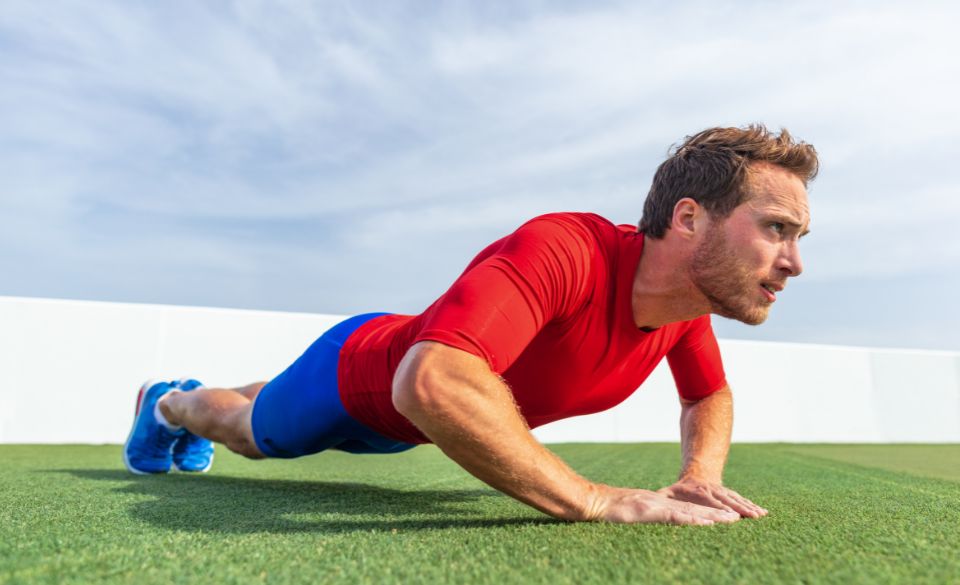
Top Shoulder Exercises For Runners: Strengthening Beyond the Legs
Page Contents
When it comes to running, most of us think about the legs, the core, and even the cardiovascular system. However, strong shoulders are a crucial part of a runner’s overall fitness. Your shoulders play a significant role in maintaining proper posture, arm swing, and balance during your runs. Neglecting them can lead to poor running form and even discomfort. In this blog post, we’ll explore the top shoulder exercises for runners to help you build strength and stability in this often overlooked area.
Why Should Runners Care About Shoulder Strength?
Before we dive into the exercises, let’s understand why shoulder strength matters for runners. Your shoulders act as a counterbalance to your lower body when you run. They help maintain an upright posture, allowing for efficient breathing and minimizing strain on your neck and lower back. Additionally, your arm swing is essential for balance and propulsion, especially during sprints or hill climbs. Weak shoulders can lead to imbalances, reduced arm swing, and potential injuries.
A study published in the “Journal of Orthopaedic & Sports Physical Therapy” highlights the importance of shoulder stability in runners. The researchers found that runners with poor shoulder stability had a higher risk of developing injuries related to their lower back and lower extremities. This underscores the need to incorporate shoulder exercises into your running routine.
The Top Shoulder Exercises for Runners
Now, let’s explore the key exercises that will help you strengthen your shoulders and improve your running performance:
1. Shoulder Press
The shoulder press is a fundamental exercise that targets the deltoid muscles, which play a significant role in shoulder stability and arm swing. To perform a shoulder press, stand or sit with a dumbbell in each hand at shoulder height. Press the dumbbells upward until your arms are fully extended, and then lower them back down. Start with a weight that allows you to perform 3 sets of 10-12 repetitions with good form.
2. Push-Ups
Push-ups are excellent for overall upper body strength, including the shoulders. Maintain a plank position with your hands slightly wider than shoulder-width apart. Lower your body by bending your elbows and then push back up to the starting position. Start with 3 sets of 8-10 push-ups and gradually increase the reps as you get stronger.
3. External Rotations
External rotation exercises target the rotator cuff muscles, which are essential for shoulder stability. You can use a resistance band for this exercise. Anchor the band at waist height, hold the other end with your hand, and keep your elbow close to your side. Rotate your forearm outward against the resistance and then return to the starting position. Perform 3 sets of 12-15 repetitions for each arm.
4. Lateral Raises
Lateral raises are great for targeting the lateral deltoids, which contribute to overall shoulder strength and stability. Hold a dumbbell in each hand at your sides with your palms facing your body. Lift your arms to the sides until they reach shoulder height, and then lower them back down. Start with 3 sets of 10-12 repetitions.
Expanding Your Shoulder Workout Arsenal
5. Upright Rows
Upright rows primarily target the upper trapezius and deltoid muscles. Hold a barbell or a pair of dumbbells with an overhand grip, hands shoulder-width apart. Keep the weights close to your body as you lift them toward your chin, leading with your elbows. Lower the weights back down slowly. Start with 3 sets of 10-12 repetitions.
6. Face Pulls
Face pulls are excellent for working the rear deltoid and upper back muscles. Attach a rope handle to a cable machine at chest height. Grab the rope handles with both hands, palms facing each other. Pull the rope toward your face while squeezing your shoulder blades together. Slowly return to the starting position. Perform 3 sets of 12-15 repetitions.
7. Bent-Over Lateral Raises
This exercise targets the posterior deltoids, which are essential for shoulder stability. Stand with your feet hip-width apart, knees slightly bent, and hold a dumbbell in each hand. Bend forward at your waist, keeping your back straight and your arms hanging in front of you. Lift your arms to the sides until they reach shoulder level, then lower them back down. Start with 3 sets of 10-12 repetitions.
8. Inverted Rows
Inverted rows are an excellent bodyweight exercise that engages the entire shoulder girdle and upper back. Set up a barbell in a rack at waist height or use a TRX suspension trainer. Lie under the bar or TRX, grasp it with an overhand grip, and hang with your body straight. Pull your chest up to the bar by squeezing your shoulder blades together, then lower yourself back down. Perform 3 sets of 8-10 repetitions.
9. Y-Raises
Y-raises specifically target the upper traps, posterior deltoids, and lower trapezius muscles. Lie face-down on an incline bench set at a low angle, or on an exercise ball with your arms hanging toward the floor, thumbs pointing up. Lift your arms toward the ceiling, forming a Y shape with your body. Lower them back down slowly. Start with 3 sets of 12-15 repetitions.
10. Plank with Shoulder Taps
Plank with shoulder taps combines core stability with shoulder strength. Begin in a forearm plank position, keeping your body in a straight line from head to heels. Lift one hand off the ground and tap the opposite shoulder, then switch to the other side. Continue alternating shoulder taps for 30-60 seconds, gradually increasing the duration as you progress.
Creating a Balanced Shoulder Routine
Building strong shoulders is a valuable asset for runners, as it contributes to better posture, balance, and overall performance. To create a balanced shoulder routine that complements your running training, follow these guidelines:
1. Warm-Up Thoroughly
Before diving into your shoulder exercises, it’s crucial to warm up properly. Spend 5-10 minutes engaging in light aerobic activity like jogging or jumping jacks to increase blood flow to your muscles. Follow this with dynamic stretches that specifically target the shoulders, such as arm circles, shoulder rolls, and cross-body arm swings. Warming up prepares your shoulder muscles for exercise and reduces the risk of injury.
2. Mix and Match Exercises
Incorporate a variety of shoulder exercises to target different muscle groups. Include movements that work the anterior deltoids (front), medial deltoids (side), posterior deltoids (rear), and the rotator cuff. A balanced routine will help you avoid muscle imbalances and ensure comprehensive shoulder strength.
3. Start with Light Weights
If you’re new to shoulder training, begin with light weights or resistance bands. Focus on proper form and control. As you become more comfortable and your strength improves, gradually increase the weight or resistance level to continue challenging your muscles.
4. Maintain Good Form
Proper form is crucial during shoulder exercises to avoid injury. Keep your back straight, engage your core, and maintain a stable base. Avoid using momentum or excessively heavy weights that can compromise your form. If you’re unsure about your form, consider working with a trainer or seeking guidance from a fitness professional.
5. Balance Push and Pull Movements
Include a balance of pushing and pulling movements in your routine. Pushing exercises, like shoulder presses and push-ups, work the anterior deltoids, while pulling exercises, such as face pulls and bent-over lateral raises, target the posterior deltoids and upper back. Balancing these movements helps maintain shoulder stability.
6. Incorporate Core Exercises
Strong shoulders are most effective when they work in harmony with a stable core. Integrate core-strengthening exercises like planks, side planks, and Russian twists into your routine. A strong core supports your posture and aids in the overall stability of your upper body during running.
7. Gradually Increase Intensity
As you progress in your training, gradually increase the intensity and volume of your shoulder exercises. You can do this by adding more sets or repetitions, increasing the weight, or trying more challenging variations of the exercises. Progression is essential for continued strength gains.
8. Prioritize Recovery
Give your shoulder muscles time to recover between workouts. Overtraining can lead to fatigue and potential injuries. Aim for at least 48 hours of rest between intense shoulder workouts. During your recovery days, focus on stretching and mobility exercises to maintain flexibility and reduce muscle tension.
9. Listen to Your Body
Pay close attention to how your shoulders feel during and after your workouts. If you experience persistent pain, discomfort, or unusual sensations, it’s essential to address them promptly. Rest, ice, and consult a healthcare professional if necessary to prevent potential injuries.
10. Consistency is Key
Consistency is the cornerstone of any effective training routine. Make shoulder strength training a regular part of your overall fitness regimen. Whether you choose to incorporate it into your running days or designate separate training days, sticking with a consistent schedule will yield the best results.
By following these guidelines, you’ll create a balanced shoulder routine that complements your running training and enhances your overall athleticism. Strong shoulders not only improve your running form but also contribute to better posture and reduced risk of injury.
Sample Shoulder Training Routine for Runners
To help you get started on your journey to stronger shoulders as a runner, here’s a sample shoulder training routine that you can incorporate into your weekly fitness plan. This routine focuses on balanced shoulder development, emphasizing both strength and stability. Remember to adjust the weights and repetitions based on your fitness level and gradually increase the intensity as you progress.
Warm-Up (5-10 minutes)
Start with a brief warm-up to prepare your shoulders for exercise. You can perform dynamic movements like arm circles, shoulder rolls, and neck stretches. The goal is to increase blood flow to the muscles and improve joint mobility.
Exercise 1: Dumbbell Shoulder Press
Target Muscles: Anterior Deltoids, Triceps
1. Sit on a bench with a backrest, holding a dumbbell in each hand at shoulder height, palms facing forward.
2. Press the dumbbells overhead until your arms are fully extended.
3. Lower the dumbbells back to shoulder height.
4. Perform 3 sets of 10-12 repetitions.
Exercise 2: Lateral Raises
Target Muscles: Medial Deltoids
1. Stand with a dumbbell in each hand at your sides, palms facing your body.
2. Lift your arms out to the sides until they reach shoulder level.
3. Lower the dumbbells back to your sides.
4. Perform 3 sets of 10-12 repetitions.
Exercise 3: Bent-Over Lateral Raises
Target Muscles: Posterior Deltoids, Upper Back
1. Stand with a dumbbell in each hand, feet shoulder-width apart.
2. Bend forward at your hips, keeping your back straight, and let the dumbbells hang in front of you.
3. Lift your arms out to the sides until they reach shoulder level.
4. Lower the dumbbells back down.
5. Perform 3 sets of 10-12 repetitions.
Exercise 4: Face Pulls
Target Muscles: Rear Deltoids, Upper Back
1. Attach a rope handle to a cable machine at chest height.
2. Grab the rope handles with both hands, palms facing each other.
3. Pull the rope toward your face while squeezing your shoulder blades together.
4. Slowly return to the starting position.
5. Perform 3 sets of 12-15 repetitions.
Exercise 5: Push-Ups
Target Muscles: Anterior Deltoids, Chest, Triceps
1. Assume a push-up position with your hands slightly wider than shoulder-width apart.
2. Lower your body by bending your elbows and then push back up to the starting position.
3. If needed, perform modified push-ups with your knees on the ground.
4. Perform 3 sets of 8-10 push-ups.
5. Cool Down and Stretching (5-10 minutes)
Finish your shoulder training with a cool-down and stretching routine. Stretch your shoulders, neck, and upper back to reduce muscle tension. Hold each stretch for 20-30 seconds, focusing on deep and controlled breathing.
Rest and Recovery:
Allow your shoulder muscles time to recover. You can perform this routine 2-3 times a week on non-consecutive days. Ensure you maintain proper form throughout the exercises, and if you experience any pain or discomfort, consult a fitness professional or healthcare provider.
Final Words – Shoulder Exercises For Runners
Don’t underestimate the importance of shoulder strength and stability in your running journey. While your lower body and cardiovascular system are undoubtedly essential, strong shoulders can significantly enhance your overall running performance. They play a pivotal role in maintaining proper posture, arm swing, and balance during your runs.
By following a well-balanced shoulder training routine like the one outlined above, you can address both strength and stability. These exercises target various shoulder muscle groups, including the anterior deltoids, medial deltoids, posterior deltoids, and upper back, ensuring a comprehensive approach to shoulder development.
Remember to warm up before your shoulder workouts, maintain proper form, and gradually increase the intensity as you progress. Also, be attentive to your body’s signals and prioritize rest and recovery to prevent overtraining.
Integrating shoulder training into your running routine can lead to better running form, reduced risk of imbalances and injuries, and ultimately, improved overall athletic performance. So, don’t neglect your shoulders – they’re an essential part of your running success.




